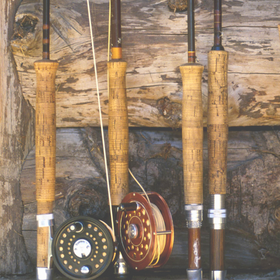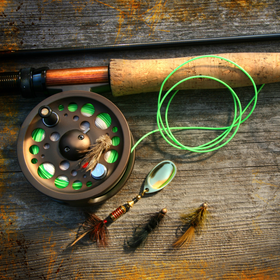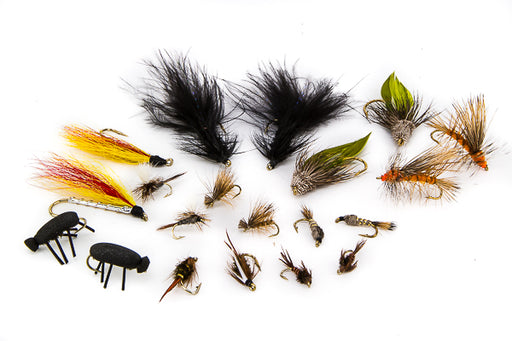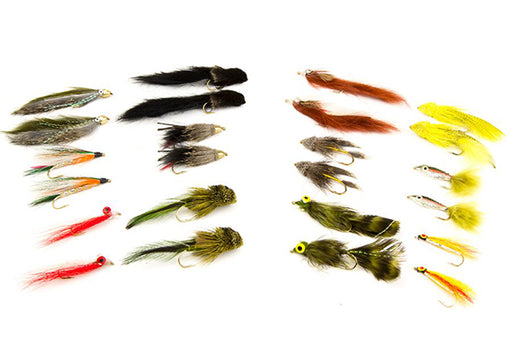
Fly Fishing Waders Guide
What types of waders are there?
Breathable
Today's modern waders are almost all "breathable" waders. This means that they are made with a material that lets air (even wet, sweaty air) out while preventing water from getting in. It allows you to expel heat instead of sitting in a soup of your own sweat while you fish.
Gore-Tex is the most widely known brand of breathable material as it was the original breathable material. However, with upgrades in technology over 30 years, there are some better materials out there and wader companies are using the best available materials, even if they don't have a recognizable name. The original Gore-tex was not very good when stretched, pulled, put under pressure, stitched or glued, but it was the start of a revolution that led us to all of these great materials that we use today.
Neoprene

Neoprene in the Winter!
Neoprene waders have their place and time, but mostly that place and time is in the past. Neoprene waders can keep you warmer in the winter months or when you are deep in a float tube in a cold lake. I own a pair and use them for those situations, but its pretty limited. If you use them in snowy, icy conditions, they are great until you stop moving and all of that sweat you are collecting starts to cool off a little....
Rubber

Rubber Hip Boots in Alaska are Common
Rubber "hippers" or hip boots are quite unusual for fly anglers these days, but are still occasionally found in the Midwest and up in Alaska on crowded streams that require little to no actual wading. They are typically used by that gear angler that fishes once a year or so. Not really an option for anyone that wants to "get into" fly fishing or is already doing it, but you might be handed a pair of them at a lodge in Alaska or wherever. We used hippers (and provided them to anglers that did not bring waders) at every lodge I worked at in AK, but we fished out of boats or on very small streams. They almost all leaked by the end of the season every year.
More on Breathable Fabrics

Orvis' diagram of their 4 an 5 layer fabrics
These breathable fabrics come in a variety of strengths and styles. Most of the breathable fabrics come in three, four or five layer styles. Each layer adds durability, but it also adds weight and cost while reducing the breathability slightly. Waders with lighter material are better in the summertime when it is warm out as they breathe better and do a poor job of retaining heat, and heavy-duty waders with thick material are better in the winter when preserving warmth is a factor.
More expensive waders have thicker fabrics that cover more area. A wader that features a five-layer fabric from ankles to waist will cost much more than a pair of waders that only has a four-layer fabric to the knees, while others do not have any five-layer material at all and rely on a three or four-layer fabric to get the job done.

Orvis PRO Waders are top-shelf
That being said, not all fabrics are the same. There are some really beefy four-layer fabrics as well as some lightweight four-layer ones. Redington's HD (Heavy Duty) Sonic Pro waders are a stout four-layer fabric, while Orvis' Clearwater Waders are a much lighter (and cheaper) four-layer.
Five-layer construction is almost exclusive to fly fishing waders, and not every company uses it. Orvis features a five-layer in their PRO waders, which is quite bomb-proof, while Redington does not use it at all.
My former roommate designed ski clothing for a very large outdoor company and had never heard of a fiver layer breathable fabric. Their heavy duty material was a four-layer fabric and that was one of the larger manufacturers of top-end ski clothing.
Seam Construction
The seams that connect the pieces of fabric together have to be sealed up and there are a couple of different methods. Some companies use stitches to sew them together and other companies use "sonic welding" to combine the materials. Either way, there is a seam that runs up the legs somewhere and it usually has another strip of fabric that covers the stitches or welding to ensure a good seal and durability.
Most wader companies are very good at this now, where seam leaking was a huge issue with many waders a generation ago. That being said, the seam is the most likely place to get a leak and seam leaks are notoriously hard to patch.
Zippers

Redington Sonic Pro Zip
That zipper on the front of the Redington Sonic Pro HDZ wader is sure nice. Is it worth the extra $100? That's a big maybe... I certainly like it and have been very glad to have it on more than one occasion. At one point, I swore I would always buy zippered waders after using them, but I have failed at that. I have never had a problem with it leaking or trying to open/close it. One drawback of the zipper is that the front of the waders are a bit stiff, which makes them a little less comfortable than others. It's not like a huge problem or anything, but it can be a little annoying when its cold and I just want my waders to be soft and easier to get into.
Convertibles

Convertibles roll down
Some waders feature a "convertible" option (like these Orvis Ultralights) Those mean that you can roll down the top part of the wader and essentially have a pair of wading pants. These waders typically feature lightweight fabrics and are aimed at summer anglers. They are typically not the best choice for someone that fishes a lot in the winter.
Proper Sizing and Leaks
I have been sizing anglers in waders for almost 20 years. I will say that most anglers will buy a pair of waders that is too small for them. It is an endemic problem. Waders should fit loosely, but not baggy. There should be zero stretching of the fabric when bending, kneeling or making a long stride.

Clearwater Waders
Stretching is where and when leaks begin. If you have a chance to try them on first, please do. When trying them on, you should make a long, kneeling stride to see if there is stretching. Also, hunching over or kneeling on one knee is a good idea to see where any potential issues are. Also, do not wear jeans or other stiff material under your waders when you are trying them on (or fishing). It is hard to determine if they fit well when the pants underneath them are thick or restrictive.
Care
Waders do need to be treated with care. There are specialty detergents for breathable fabrics that can be found at the big box stores. I personally use the fancy powdered "pure" detergents that have no dyes or scents instead of the expensive one-use bottle from REI, although the wader manufacturers would really prefer if you bought the TechWash.
I turn the waders inside out and wash them with cold water on gentle cycle with a couple of towels. After the cycle is over, I turn them out again and rinse them off in the shower as soap will collect in the legs in the wash.
The next thing for proper wader care is to hang them to dry and for storage. Waders that are folded up and stored in the closet can develop creases in the fabric, which can lead to leaks. This is especially true when they are not properly washed. Grease, dirt and sweat will collect on them and cause the fabric to become brittle, leading to leaks. I have a coat rack in my "office" where all of my waders and rain jackets are stored. Do not put a pair of waders in the dryer.
Story time. I went on a guided jet boat trip for winter steelhead a few years back. My (now ex) girlfriend had thrown my waders in the dryer on accident and I did not know. All of the seams were pretty much blown open, which I found out about ten minutes into the first spot. It was the single coldest, wettest day of fly fishing that I have ever had. I felt terrible for the guy who went with me as I just couldn't keep fishing after a couple of hours. Hypothermia is no joke.
Under Wader Wear
Above, I mentioned jeans under waders; it is not at all recommended. Jeans are stiff and can quickly wear down the material on the inside of the waders, leading to leaks. Plus the cotton material makes them cold and they will soak up any sweat or water that you may run into. While waders can keep water out, condensation can happen inside of your waders, especially when the air and water are really cold. Wearing breathable fabrics like smartwool or synthetics is a must. There is a saying in the outdoor industry: Cotton is rotten. Just avoid it and use synthetics or wool.
Leaks

Aquaseal Patch Kit
Leaks happen. It is part of owning waders. There are a couple of reasons that waders leak. The first, as mentioned above is fabric stretching. Anywhere that the material is getting pulled will eventually leak. Around the knees, crotch and ankles are the most likely places to get a leak and that is because those are the places that the material gets stretched out when you take a big step, kneel down, or do whatever to cause it to tighten up too much.
In the Northwest among other places, blackberries are a serious problem. They are everywhere along rivers in western Oregon and Washington. Beyond being delicious, they are covered in thorns that have an amazing ability to find your new waders no matter how careful you are. The world is a big place and thorny bushes like blackberries love to grow around rivers, so there is likely some wader-snagging bushes near you even if they are not as delicious.

Excellent investment
When you discover that your waders are leaking, there are a couple of things to do. The first is to consider the warranty on those waders. Many waders companies will patch a pair of waders or replace them for you within a warranty time-frame. If you do not have the time to send them in, there are a few options for patching them. I prefer rubbing alcohol to find the leaks and Aquaseal along with a fabric patch to fix them on the outside of the wader. If its not leaking from the outside, it can't be leaking on the inside either... There are some great videos online about patching waders including how to use rubbing alcohol to find the leaks. You do not have to fill them up with water to find the leaks.
Another item that is always in my fishing bag is Loon's UV Wader Repair. This stuff dries almost instantly in the sun and has been a lifesaver on the stream more than once when discovering that fresh new leak that wasn't there last week.
Final Thoughts
Waders are quite expensive just like much of the other gear that you need to be really proficient at fly fishing. The thing that really sucks about waders is that you do have to buy them every couple of years. They have the shortest life span for the most amount of money that you spend on an item. Rods and reels can last a lifetime, but all waders will leak and eventually fail. Buying a quality pair in the right size along with proper care will help them last as long as possible.









